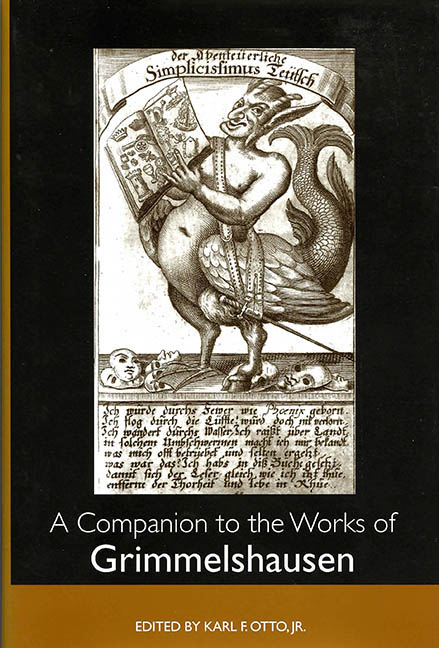Book contents
- Frontmatter
- Contents
- Illustrations
- Acknowledgments
- Chronological List of Grimmelshausen's Works and Their First English Translation
- Introduction
- I Basics
- Problems in the Editions of Grimmelshausen's Works
- Grimmelshausen's “Autobiographies” and the Art of the Novel
- Allegorical and Astrological Forms in the Works of Grimmelshausen with Special Emphasis on the Prophecy Motif
- Grimmelshausen and the Picaresque Novel
- Grimmelshausen's Ewig-währender Calender: A Labyrinth of Knowledge and Reading
- Grimmelshausen's Non-Simplician Novels
- In Grimmelshausen's Tracks: The Literary and Cultural Legacy
- II Critical Approaches
- Notes on the Contributors
- Index
In Grimmelshausen's Tracks: The Literary and Cultural Legacy
from I - Basics
Published online by Cambridge University Press: 27 April 2017
- Frontmatter
- Contents
- Illustrations
- Acknowledgments
- Chronological List of Grimmelshausen's Works and Their First English Translation
- Introduction
- I Basics
- Problems in the Editions of Grimmelshausen's Works
- Grimmelshausen's “Autobiographies” and the Art of the Novel
- Allegorical and Astrological Forms in the Works of Grimmelshausen with Special Emphasis on the Prophecy Motif
- Grimmelshausen and the Picaresque Novel
- Grimmelshausen's Ewig-währender Calender: A Labyrinth of Knowledge and Reading
- Grimmelshausen's Non-Simplician Novels
- In Grimmelshausen's Tracks: The Literary and Cultural Legacy
- II Critical Approaches
- Notes on the Contributors
- Index
Summary
The Calendars
Even while Grimmelshausen was still alive, his publisher, Felssecker, attempted to use the success of Simplicissimus Teutsch and the word “Simplician,” quite independent of the author himself, for other books from his publishing house. In the same year he published Grimmelshausen's Ewig-währender Calender (1670), he published an additional annual “Simplician” calendar along with five other calendars which he had been publishing since 1661. This annual calendar appeared continually until 1747, and after that year, due to a change in publishers, in the Endter publishing house until 1807. It consists of two parts. The first part, entitled Glücklicher und Unglücklicher seltzamer und notabler ganz neuer Europäischer Wundergeschichten Calender, contains the calendar itself along with “Scherzreden deß Abentheurlichen Simplicissimi” and “Simplicianische Wunder-Geschichten” in two columns. These sections contain three further “Continuationen” of Simplicissimus Teutsch, which Felssecker then included in the fifth edition of Simplicissimus Teutsch (1671). The second part, entitled Grosses astrologisches Jahrbuch, contains various prognoses about the future in the form of a conversation between Simplicissimus, his son, the merchant Politicus, the innkeeper Schrepffeisen, and the charlatan Kugelmann. Beginning in 1673, various picaresque novel characters are also included in the conversation, including Don Buscon, Gusman, Jan Perus, and Gonella. The conversations deal with topics such as the seasons of the year, the months, signs of the zodiac, weather predictions, humorous tales, notes about solar and lunar eclipses, dangers of war, diseases, and, finally, predictions about the coming harvest. Of those annual calendars that appeared during Grimmelshausen's lifetime, the ones from 1670 and 1674 no longer exist, only the second parts (the predictions) from the calendars of 1671 and 1673 are available, and only the two years 1672 and 1675 are still available in their entirety.
The question about whether or not this calendar might be attributed to Grimmelshausen has long been the subject of scholarly debate (von Ziegesar 1924, Koschlig 1939 and 1977, Weydt 1979). The following considerations seem to indicate that they should not be considered works of Grimmelshausen. First, the Simplician calendars cannot really be distinguished from other annual calendars produced by Felssecker in terms of conception, material, or style. Second, it is clear that the humorous stories and tales in the supposedly Simplician sections are compiled from current collections of apothegma and narratives.
- Type
- Chapter
- Information
- A Companion to the Works of Grimmelshausen , pp. 231 - 266Publisher: Boydell & BrewerPrint publication year: 2002

